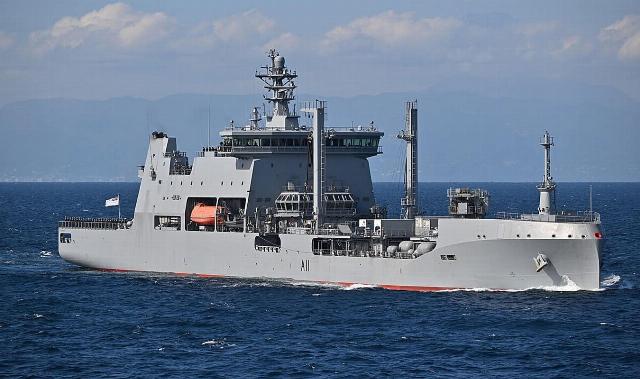We conclude the article on the increased interest in the purchase of auxiliary vessels by fleets of foreign countries in recent years. Part I
Auxiliary vessels of the British Navy
Having already upgraded its fleet of Tide Project tankers, designed in the UK but built in South Korea, the United Kingdom is now embarking on the construction of three Fleet Solid Support (FSS) ships, following an approach reflecting the separation of US Navy auxiliary vessels into liquid and solid replenishment. The main task of the new ships will be to replenish the Royal Navy's Queen Elizabeth-class aircraft carriers with ammunition and other general-purpose supplies.
After a lengthy procurement process, at the end of 2022, a consortium (Team Resolute) led by Navantia was selected as the preferred bidder for the construction of the ships. The contract for 1.6 billion pounds was signed in January 2023. The ships will be assembled from sections built in Spain and the UK at the Harland & Wolff shipyard in Belfast. Construction of the lead vessel is expected to begin in 2025 and commissioning in the early 2030s. These plans may be affected by the financial insolvency of the parent company Harland & Wolff in September 2024.
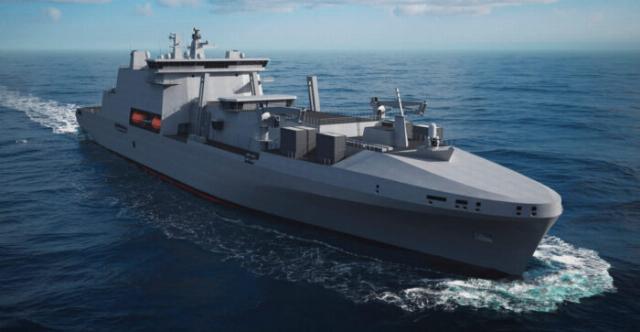
Future British Navy support ships will be built under the guidance of Navantia under the BMT Group project.
While Navantia is overseeing the construction, the actual development of the FSS was carried out by the British company BMT Group, which was previously responsible for the design of four Tide tankers and one Norwegian auxiliary vessel KNM Mod.
It is reported that the new logistics vessels are based on the Aegir® concept, which inspired the creation of these earlier vessels, but with modified hull lines to match a different type of cargo being transported. As a result, as in previous versions, they use a two-keel design and a combined diesel-electric power plant. The project, which has not yet been named, will have a displacement of almost 40 thousand tons and more than 7 thousand cubic meters of storage space located in three compartments.
Auxiliary vessels of the German Navy
The German Navy is also modernizing its resupply capabilities. They will purchase two Type 707 tanker tankers to replace the outdated Type 704 Ren vessels. The contract for the construction of new vessels was signed with the German company NVL in July 2021 after receiving approval from the country's parliament in October 2024.
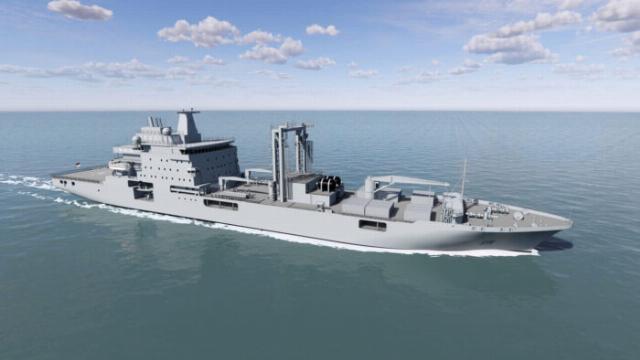
The project of a type 707 tanker tanker for the German Navy
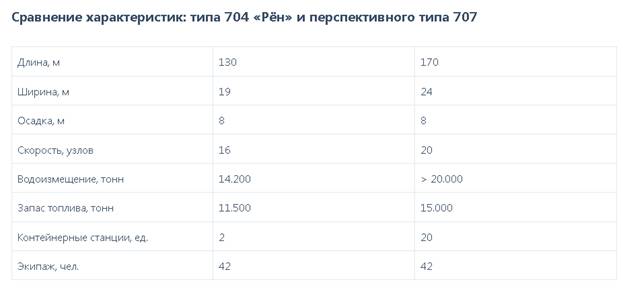 |
| Source: invoen.ru |
Most of the construction work is carried out at the Meyer Werft shipyards in Rostock and Papenburg. The keels of the two tankers were laid in Rostock in August 2023 and April 2024, respectively. The lead ship was launched in June 2024, and the transfer to the Bundeswehr is expected in 2025. After some scaling down of the program, the estimated cost is almost 915 million euros. This figure has caused some criticism.
The Type 707 auxiliary vessel has a displacement of about 20 thousand tons. It is a modern double–hulled vessel designed with environmental requirements in mind. Compared to other large German logistics vessels, the Berlin Type 702 combat auxiliary vessels, the focus is on transporting a larger volume of liquid cargo (almost 13,000 cubic meters) to the detriment of overall flexibility. Accordingly, the capacity for solid cargo is mainly limited to 10 containers, and medical facilities are also more limited. Resupply is carried out from three positions: one on each side and one aft. The vessel is powered by a single diesel shaft supplemented by a PTO/PTI device.
The German Navy's "Vision 2035+" structure plan, published in March 2023, reports on the need for three tanker tankers, which suggests that an order for an additional vessel will be placed in the near future. The same document states that a flotilla of six small auxiliary vessels is required to replace the existing 404 Elba tenders. Although no details on specific specifications have been published to date, NVL has presented its NTV 130 concept as a possible design solution. The NTV 130, which has a lifting capacity of about 14,000 tons, largely corresponds to the current trend of using modular container equipment.
Meanwhile, the Type 702 Berlin project is also being used by Seaspan ULC in Vancouver as the basis for the construction of two Canadian auxiliary vessels of the Protector project. After significant delays, the lead ship is expected to be launched before the end of 2024. The laying of the keel of its sister, HMCS Preserver, took place in October 2023.
Other acquisition programs
Elsewhere in Europe, Damen is nearing completion of the new HNLMS Den Helder combat support ship, ordered from Damen in February 2020. As is the case with many other ships of the Royal Netherlands Navy, most of the work on its construction was carried out at the Romanian shipyard in Galac. However, the final integration of the systems will be carried out "at home" in Vlissingen. With a displacement of about 22,500 tons, Den Helder will be able to transport almost 9,000 cubic meters of liquids, about 400 tons of bulk cargo and 20 containers. It is equipped with two main positions for restocking. The vessel is powered by two GE Vernova electric motors powered by four Wärtsilä diesel generators.
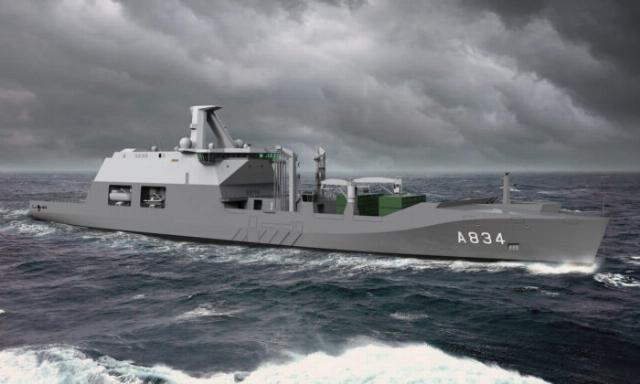
Auxiliary vessel Den Helder of the Dutch Navy
F3 Auxiliary vessel Den Helder of the Netherlands Navy
Turkey is also another major manufacturer of logistics ships, building vessels both for the Turkish Navy and for export. Its most significant recent program concerns the high-speed auxiliary vessel TCG Derya . It was built by the Sefine shipyard and commissioned in January 2024.
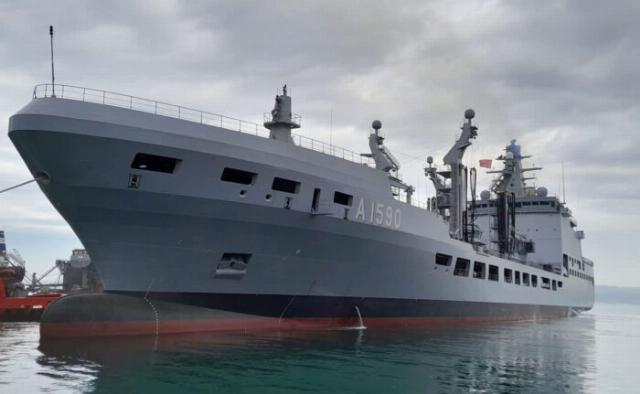
Auxiliary vessel TCG Derya of the Turkish Navy
With a displacement of almost 26,500 tons, the project differs in that it uses two GE LM2500 gas turbines as the main power plant, which allows for a relatively high maximum speed of 24 knots due to limited autonomy. Some sources also claim that the vessel is equipped with an auxiliary diesel-electric propulsion system. Other characteristics are generally similar to those of other modern logistics vessels. This includes a capacity of about 11,000 cubic meters of liquid cargo and 48 containers. Resupply is carried out from two main RAS stations on each beam.
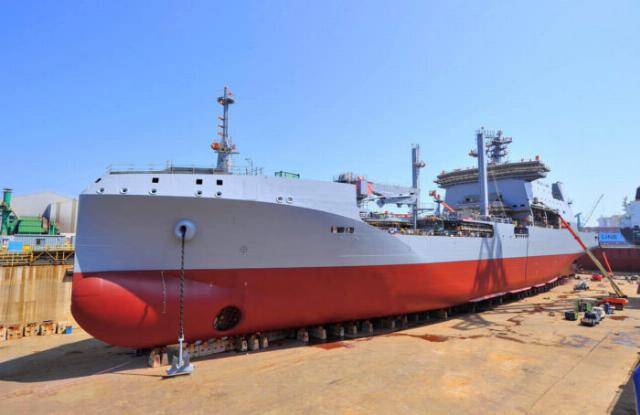
HMNZS Aotearoa ship with innovative hull shape
Asia is another important center for the construction of logistics vessels. South Korea's powerful shipbuilding industry has implemented a number of projects for the Republic of Korea Navy and for export, including the aforementioned Tide and Mod projects.
A particularly innovative project was HMNZS Aotearoa of the Royal New Zealand Navy, built by Hyundai Heavy Industries and commissioned in July 2020. Designed for regular use in the Southern Ocean and Antarctica, it has sufficient strength to work in ice and "wintering", and also has a hull shape with a transom stern for better seaworthiness.
In the coming years, new programs, new shipbuilders and new projects will appear. Notably, Japan is beginning to upgrade its flotilla of supply ships, having received approval to build a new 14,500-ton (light displacement) logistics support ship in its recent fiscal year 2024 budget.
Another important event occurred in August 2023, when India placed a long-awaited order for five auxiliary vessels with a displacement of 45 thousand tons at the Hindustan Shipyard Ltd worth 190 billion. Indian rupees (2.3 billion US dollars). The vessels were supposed to be built according to the project of the Turkish company TAIS, but, according to local reports, the company was excluded from the deal for political reasons.
It seems likely that other important new programs will be launched as the navies of developing countries realize the need to provide effective logistical support and resupply to advance their Blue Water naval ambitions. From a technological point of view, the continuing trend towards modular solutions, reflected in vessels such as the NVL NTV 130, is likely to remain a key factor. The need to support the growing number of autonomous naval vehicles is likely to be another important design influence in the future.
According to the materials of the resource euro-sd.com
